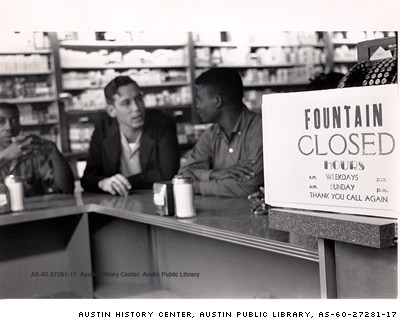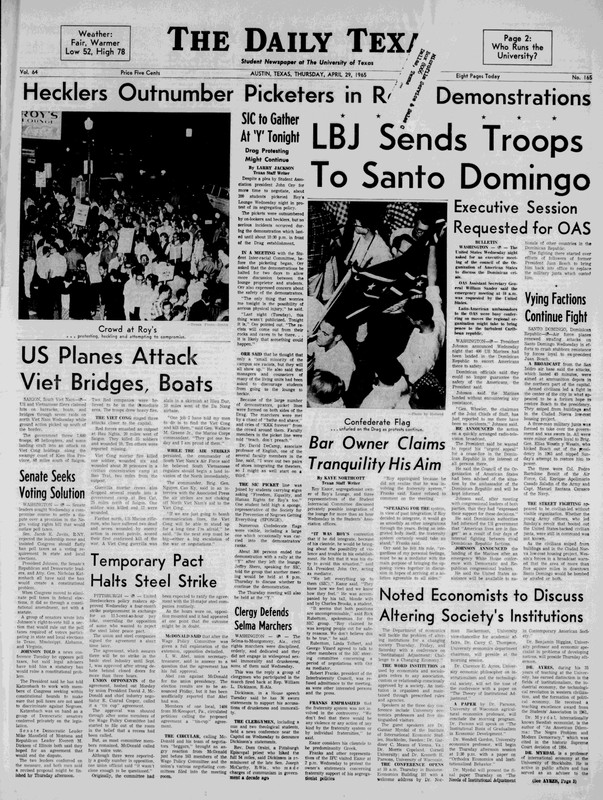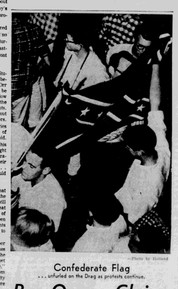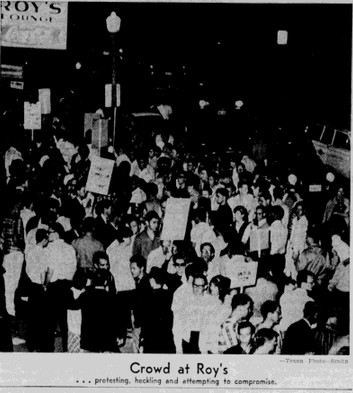University of Texas students protest racial segregation at Roy's Lounge, 1965
Introduction
Text-to-speech Audio
At this location in the spring of 1965, hundreds of students at the University of Texas held a series of afternoon demonstrations against Roy's Lounge, an establishment known for racial discrimination even after the passage of the 1964 Civil Rights Act. The restaurant maintained its policy against serving African Americans inside the establishment and also responded by refusing to serve any known white member of the Student Interracial Committee. Over time, hundreds of students held signs and maintained a picket line to discourage others from patronizing the establishment. While the administration of the University of Texas was not supportive of the actions of their white and Black students, and while the leaders of student government counseled "patience," the students persisted in holding pickets throughout April and were met by hundreds of white hecklers. Many of the white counter-protesters chanted "KKK forever" and waved Confederate flags to antagonize the white and Black students who sought racial equality. The students were joined by several professors, including Dr. David DeCamp who had participated in an earlier campaign against segregation in Austin theaters.
Images
White and African American students from several area colleges picket businesses on Congress Avenue urging integration of lunch counters.

Austin Daily Texan, April 29, 1965

Numerous white counter-protesters waved Confederate flags and chanted "KKK forever"

Two hundred students participate in a picket against Roy's Lounge on April 28, 1965.

Backstory and Context
Text-to-speech Audio
College communities in the South such as Austin saw some of the earliest and most significant acts of protest against segregation. In 1953, for example, Myrtle Washington was arrested for refusing to move to the rear of an Austin Transit Company bus. She was represented by Arthur Dewitty and the Austin Chapter of the National Association for the Advancement of Colored People (NAACP) who used her arrest to challenge the legality of Austin's segregation law.
While her case did not result in the immediate end of segregation on buses, her actions and that of many others created an environment where white and Black residents and students challenged segregation in the late 1950s and early 1960s. Austin students also protested against the university's policy of maintaining separate dorms for white and Black students in May of 1965. Despite opposition by the university's dean of students, the students presented a resolution calling for the end of racial segregation in the dormitories of the university to the Faculty Council.
These actions led to a gradual end to segregation in most Austin establishments before the passage of the 1964 Civil Rights Act, but there were establishments such as Roy's Lounge that openly violated the law while many others took actions to make Black customers feel unwelcome. Protests against Roy's continued throughout April and May as owner Roy Eazor claimed that the only reason he refused to integrate was his fear of violence by his white patrons against African Americans. Numerous white counter-protesters waved Confederate flags--a scene that was common in the early and mid-1960s as the "Stars and Bars" was utilized as a symbol of white supremacy. Some students and community members expressed their belief that the civil rights movement was about victimizing whites. For example, some white students formed a short-lived anti-civil rights organization known as SPONGE: The Society for the Prevention of Negroes Getting Everything."
Other white Austin residents increasingly came to see the issue of racial integration as something that could divide residents and harm their businesses and other residents. While local Republican Party leaders were mostly silent on the issue, Black Republicans and young white Republicans sought to stem the drift of their political party against the civil rights movement. While most African Americans had supported the Republican Party before World War II, by the mid-1960s, political realignment saw some Southern Republican leaders courting white voters through opposition to civil rights laws. Leading national Republicans such as Presidential nominee Barry Goldwater opposed the 1964 Civil Rights Act, as did John Tower, the first Republican Senator to represent Texas since Reconstruction.
Tom Dixon, an African American businessman from Houston who continued to support the Republican party estimated that only twenty percent of Black voters continued to support his party and urged party leaders to "do something" to retain the support of Black voters. While the Young Republicans passed a resolution urging the owner of Roy's to voluntarily open his business to all, other Southern Republicans avoided the issue in ways that reflected the realignment of the party on matters related to race.
Students joined area residents and following the assassination of Martin Luther King Jr. in 1968, the city of Austin passed an ordinance barring racial segregation in businesses that served the public within city limits. Of course, the 1964 Civil Rights Act already barred racial segregation, but this law served as an official endorsement of a law some white Southerners still refused to recognize. The city also passed an ordinance barring racial discrimination in housing.
While her case did not result in the immediate end of segregation on buses, her actions and that of many others created an environment where white and Black residents and students challenged segregation in the late 1950s and early 1960s. Austin students also protested against the university's policy of maintaining separate dorms for white and Black students in May of 1965. Despite opposition by the university's dean of students, the students presented a resolution calling for the end of racial segregation in the dormitories of the university to the Faculty Council.
These actions led to a gradual end to segregation in most Austin establishments before the passage of the 1964 Civil Rights Act, but there were establishments such as Roy's Lounge that openly violated the law while many others took actions to make Black customers feel unwelcome. Protests against Roy's continued throughout April and May as owner Roy Eazor claimed that the only reason he refused to integrate was his fear of violence by his white patrons against African Americans. Numerous white counter-protesters waved Confederate flags--a scene that was common in the early and mid-1960s as the "Stars and Bars" was utilized as a symbol of white supremacy. Some students and community members expressed their belief that the civil rights movement was about victimizing whites. For example, some white students formed a short-lived anti-civil rights organization known as SPONGE: The Society for the Prevention of Negroes Getting Everything."
Other white Austin residents increasingly came to see the issue of racial integration as something that could divide residents and harm their businesses and other residents. While local Republican Party leaders were mostly silent on the issue, Black Republicans and young white Republicans sought to stem the drift of their political party against the civil rights movement. While most African Americans had supported the Republican Party before World War II, by the mid-1960s, political realignment saw some Southern Republican leaders courting white voters through opposition to civil rights laws. Leading national Republicans such as Presidential nominee Barry Goldwater opposed the 1964 Civil Rights Act, as did John Tower, the first Republican Senator to represent Texas since Reconstruction.
Tom Dixon, an African American businessman from Houston who continued to support the Republican party estimated that only twenty percent of Black voters continued to support his party and urged party leaders to "do something" to retain the support of Black voters. While the Young Republicans passed a resolution urging the owner of Roy's to voluntarily open his business to all, other Southern Republicans avoided the issue in ways that reflected the realignment of the party on matters related to race.
Students joined area residents and following the assassination of Martin Luther King Jr. in 1968, the city of Austin passed an ordinance barring racial segregation in businesses that served the public within city limits. Of course, the 1964 Civil Rights Act already barred racial segregation, but this law served as an official endorsement of a law some white Southerners still refused to recognize. The city also passed an ordinance barring racial discrimination in housing.
Sources
Austin Daily Texan, April 29, 1965.
Austin Daily Texan, May 7, 1965.
Austin Public Library, Desegregation in Austin: http://www.austinlibrary.com/ahc/desegregation/index.cfm
Austin Daily Texan, May 7, 1965.
Austin Public Library, Desegregation in Austin: http://www.austinlibrary.com/ahc/desegregation/index.cfm
